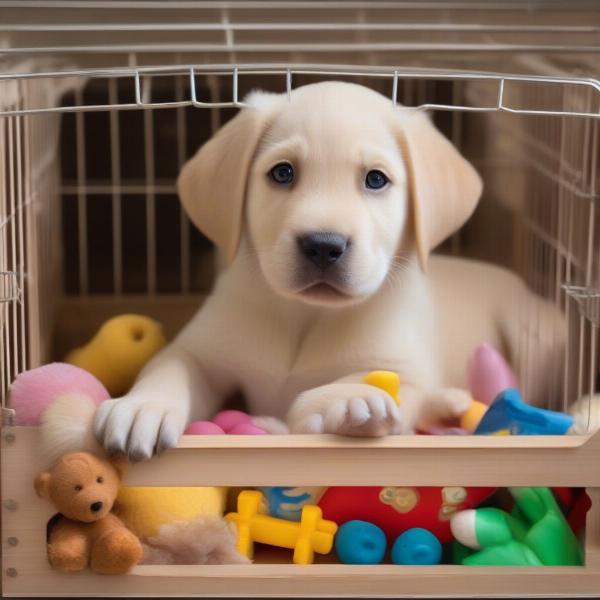Choosing the right dog crate for your Labrador Retriever is a crucial decision that impacts their comfort, safety, and overall well-being. Whether you’re bringing home a playful puppy or have an adult Lab, a crate can be a valuable tool for housetraining, providing a safe haven, and managing any potential behavioral issues. This guide will cover everything you need to know about selecting the perfect crate for your Labrador, from size and type to essential features and training tips.
Choosing the Right Size Crate for Your Lab
Labrador Retrievers are medium to large-sized dogs, so choosing a crate that accommodates their adult size is essential. A crate that’s too small will restrict their movement and make them feel uncomfortable, while one that’s too large may encourage them to use one end as a bathroom. Measure your Lab from nose to tail base and from the floor to the top of their head (while standing). Add 2-4 inches to both measurements to determine the ideal crate dimensions. You can also check our guide on dog crate sizes by breed for more information.
Types of Dog Crates for Labs
Several types of dog crates are available, each with its pros and cons. Wire crates offer excellent ventilation and visibility, making them a good choice for Labs, who can be prone to overheating. Plastic crates offer more privacy and are easier to clean, while heavy-duty metal crates are best for Labs who are strong chewers or escape artists.
Wire Crates: Pros and Cons
Wire crates are a popular choice for their durability and affordability. They allow for good airflow and give your Lab a clear view of their surroundings. However, they offer less privacy and can be noisy if your dog likes to rattle the bars.
Plastic Crates: A Cozy Den
Plastic crates offer more privacy and are generally quieter than wire crates. They’re also easier to clean and can provide a sense of security for anxious dogs. However, they offer less ventilation, so it’s important to ensure adequate airflow, especially in warmer climates.
Heavy-Duty Crates: For the Escape Artist
For particularly strong or determined Labs, a heavy-duty metal crate may be necessary. These crates are designed to withstand chewing and escape attempts, offering maximum security.
Essential Features to Look For
Regardless of the type of crate you choose, certain features are essential for your Lab’s comfort and safety. Look for a crate with a sturdy construction, secure latches, and rounded corners to prevent injuries. A removable tray makes cleaning easier, while a comfortable bed will encourage your Lab to relax and enjoy their time in the crate. Check out our selection of white dog crates if you are looking for a specific aesthetic.
Crate Training Your Labrador Retriever
Crate training should be a positive experience for your Lab. Start by introducing them to the crate gradually, using treats and praise to create positive associations. Never force your Lab into the crate or use it as punishment. Keep the crate in a central location in your home so your Lab feels included in family activities. For more information, visit our article on contour dog crate.
 Labrador puppy happily exploring its new crate with toys and treats.
Labrador puppy happily exploring its new crate with toys and treats.
Conclusion
Choosing the right dog crate is an investment in your Labrador Retriever’s well-being. By considering their size, breed-specific needs, and individual personality, you can create a safe and comfortable space where they can thrive. Remember, a crate should be a positive and enriching part of your Lab’s life, not a confinement area.
FAQ
- What size crate do I need for an adult Labrador Retriever? A 36-48 inch crate is usually suitable for adult Labs.
- Are wire crates good for Labradors? Yes, wire crates provide good ventilation, which is essential for Labs.
- How do I crate train my Lab? Introduce the crate gradually, using positive reinforcement and making it a comfortable space.
- Can I leave my Lab in a crate all day? No, adult Labs shouldn’t be crated for more than 6-8 hours at a time.
- What if my Lab cries in the crate? Ignore the crying unless it’s due to distress, and ensure they’ve been properly exercised and toileted before crating.
- Are dog cages for medium dogs suitable for Labradors? While Labradors are on the larger side of medium, a medium dog cage might be suitable for a smaller Labrador, but always measure your dog to ensure a proper fit.
- What are the recommended dog crate sizes uk? UK dog crate sizes are typically measured in inches and are similar to the US sizing recommendations, with a 36-48 inch crate usually recommended for an adult Labrador.
About ILM Dog
ILM Dog is your trusted international resource for expert dog care advice, covering everything from breed selection and health to training, nutrition, and grooming. We are dedicated to providing practical, reliable information to empower dog owners worldwide. Whether you’re a first-time puppy parent or a seasoned dog lover, we’re here to help you navigate every aspect of dog ownership. For expert guidance and personalized advice, contact us at [email protected] or call us at +44 20-3965-8624.